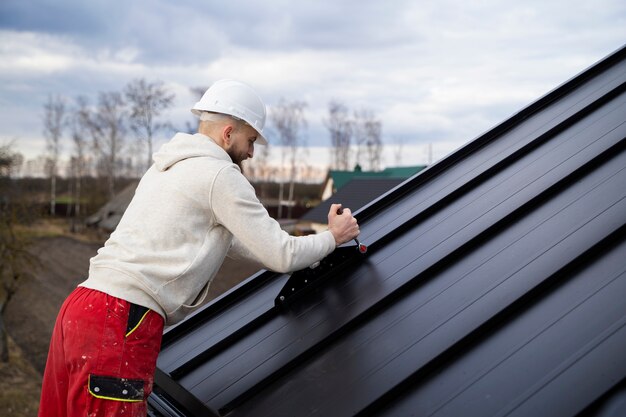Table of Contents
How to Replace a Shingle: Steps Involved
Replacing a damaged shingle on your roof is a relatively straightforward DIY task that can prevent further damage to your home stopping leaks and protecting the integrity of the roof. Here’s a step--step guide on how to replace a shingle:
Tools and Materials Needed:
- Replacement shingles
- Pry bar or flat pry tool
- Hammer
- Roofing nails
- Utility knife
- Roofing sealant or adhesive
- Ladder
- Safety gear (gloves, non-slip shoes, safety harness, etc.)
Step--Step Instructions:
1. Ensure Safety First
Wear Safety Gear: Put on gloves, non-slip shoes, and use a safety harness to prevent falls.
Use a Stable Ladder: Make sure your ladder is stable and placed on a flat surface. If possible, have someone hold the base of the ladder for added safety.
Check Weather Conditions: Make sure the weather is dry and calm. Avoid replacing shingles during rain or high winds.
2. Identify the Damaged Shingles
Locate Damaged Areas: Inspect your roof and identify the damaged or missing shingles. Often, shingles will be cracked, curled, or missing granules.
Assess the Damage: If multiple shingles are damaged or if there is widespread damage, consider whether a larger repair or professional help is needed.
3. Remove the Damaged Shingle
Lift the Adjacent Shingles: Use a pry bar or flat pry tool to gently lift the shingles above the damaged one. This will expose the nails holding the damaged shingle in place.
Remove the Nails: Slide the pry bar under the shingle and carefully lift to remove the nails. Most shingles are held down four nails: two at the top and two at the bottom. Be careful not to damage the adjacent shingles.
Slide Out the Damaged Shingle: Once the nails are removed, slide the damaged shingle out from under the remaining shingles.
4. Prepare the Replacement Shingle
Trim the Shingle if Necessary: Use a utility knife to cut the replacement shingle to match the size of the existing shingles if necessary.
Check the Fit: Slide the new shingle into place to ensure it fits properly before nailing it down.
5. Install the Replacement Shingle
Nail the Shingle in Place: Align the new shingle with the existing shingles on both sides. Use roofing nails to secure it, placing the nails where the old nails were removed (usually about 1 inch above the cutout, or tab, of the shingle).
Use Four Nails: Install two nails at the top and two at the bottom of the replacement shingle. Make sure the nails are flat against the shingle, but do not overdrive them, as this could cause damage.
6. Seal the Replacement Shingle
Apply Roofing Sealant: Lift the shingles above the replacement and apply a small amount of roofing sealant or adhesive under the corners of the new shingle to secure it in place.
Press Down Firmly: Press down on the shingle to adhere it to the roof and to ensure it is flat and level with the surrounding shingles.
7. Inspect the Repair
Check for Proper Alignment: Ensure that the replacement shingle is properly aligned with the other shingles and that there are no gaps or lifted edges.
Test for Secure Attachment: Tug gently on the shingle to make sure it is securely fastened and will not move or come loose.
8. Clean Up
Dispose of Old Shingles Properly: Collect the damaged shingles and any other debris and dispose of them according to local regulations.
Check for Loose Nails: Make sure there are no loose nails or debris left on the roof that could cause damage or pose a safety risk.
9. Monitor the Repair
Inspect After the First Rain: After the first rainfall or windstorm, check the repaired area to ensure the new shingle is secure and there are no leaks.
Regular Roof Inspections: Continue to inspect your roof periodically to catch any future damage early.
Tips for a Successful Shingle Replacement:
Work in Cool Weather: Shingles are more flexible and easier to handle when the weather is cool, especially if you’re working with asphalt shingles.
Buy Extra Shingles: Keep a few extra shingles on hand for future repairs. This ensures you have a matching shingle if another repair is needed later.
Consider Shingle Type: Match the replacement shingle type, color, and material to the existing ones for a seamless look.
When to Call a Professional:
If you find multiple damaged shingles, structural damage to the roof, or are uncomfortable with heights and roof work, it’s best to call a professional roofer to handle the repair.
By following these steps, you can replace a damaged shingle effectively, protecting your home from water damage and maintaining the overall integrity of your roof. If you have any further questions or need additional guidance, feel free to ask!

Roof Restoration Canberra
Giralang, ACT 2617 Australia
Phone Number: (02) 6171 6119
Business Email: sales@roofrestorationcanberra.com
Website: https://roofrestorationcanberra.com/
Map: https://goo.gl/maps/H44Hnf2ugxaHYmEC8
Social media links:
https://www.facebook.com/Roof-Restoration-Canberra-904886509628012/
https://twitter.com/RooferCanberra




